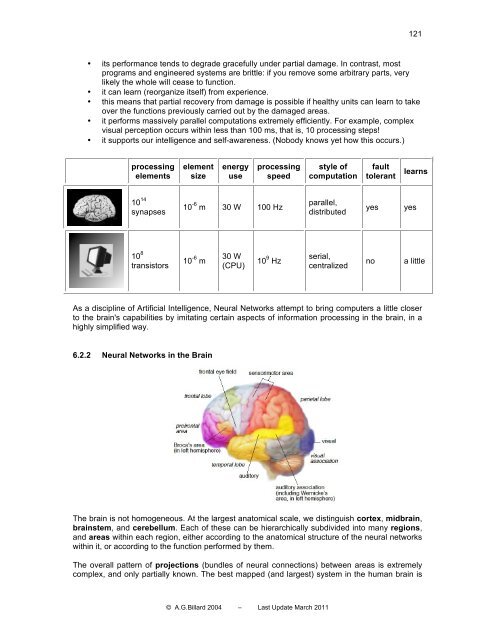MACHINE LEARNING TECHNIQUES - LASA
MACHINE LEARNING TECHNIQUES - LASA
MACHINE LEARNING TECHNIQUES - LASA
Create successful ePaper yourself
Turn your PDF publications into a flip-book with our unique Google optimized e-Paper software.
121<br />
• its performance tends to degrade gracefully under partial damage. In contrast, most<br />
programs and engineered systems are brittle: if you remove some arbitrary parts, very<br />
likely the whole will cease to function.<br />
• it can learn (reorganize itself) from experience.<br />
• this means that partial recovery from damage is possible if healthy units can learn to take<br />
over the functions previously carried out by the damaged areas.<br />
• it performs massively parallel computations extremely efficiently. For example, complex<br />
visual perception occurs within less than 100 ms, that is, 10 processing steps!<br />
• it supports our intelligence and self-awareness. (Nobody knows yet how this occurs.)<br />
processing<br />
elements<br />
element<br />
size<br />
energy<br />
use<br />
processing<br />
speed<br />
style of<br />
computation<br />
fault<br />
tolerant<br />
learns<br />
10 14<br />
synapses<br />
10 -6 m 30 W 100 Hz<br />
parallel,<br />
distributed<br />
yes<br />
yes<br />
10 8<br />
transistors<br />
10 -6 m<br />
30 W<br />
(CPU)<br />
10 9 Hz<br />
serial,<br />
centralized<br />
no<br />
a little<br />
As a discipline of Artificial Intelligence, Neural Networks attempt to bring computers a little closer<br />
to the brain's capabilities by imitating certain aspects of information processing in the brain, in a<br />
highly simplified way.<br />
6.2.2 Neural Networks in the Brain<br />
The brain is not homogeneous. At the largest anatomical scale, we distinguish cortex, midbrain,<br />
brainstem, and cerebellum. Each of these can be hierarchically subdivided into many regions,<br />
and areas within each region, either according to the anatomical structure of the neural networks<br />
within it, or according to the function performed by them.<br />
The overall pattern of projections (bundles of neural connections) between areas is extremely<br />
complex, and only partially known. The best mapped (and largest) system in the human brain is<br />
© A.G.Billard 2004 – Last Update March 2011

















